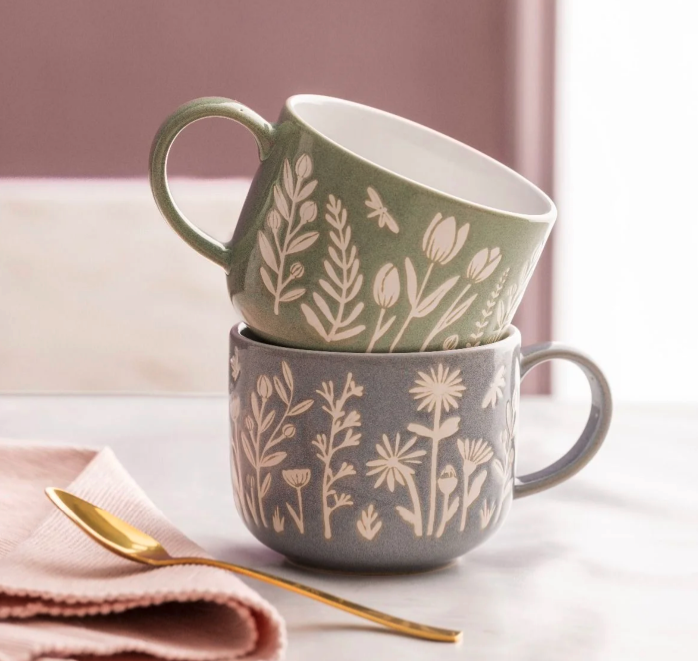Paige Knight - 13 / Apr / 2024
The Art of Tea
Want to learn about the art of tea? From loose leaf to bagged and earl grey to matcha, we cover the 3 most common teas so that you can brew the perfect cup.

From loose leaf to bagged and earl gray to matcha, tea is a diverse and complex art form. I used to think that all teas were more or less the same; all you need to do is add boiling water and let it sit for 10 minutes, right? Wrong. With a rich history dating back to 2700 BCE, there are a wide variety of tea types, each with their own historical significance, health benefits, and unique brewing methods.
Tea is one of the most widely consumed beverages in the world (next to water), and it’s no mystery why. Beyond providing warm, cozy vibes, tea comes with a slew of health benefits and diverse flavors. Let us walk you through the most common types of tea, from where they come from to how they’re made, so you can master the art form and make the perfect cup.
Why Tea?
Did you know that tea has been used for medicinal purposes for centuries? In ancient China, tea was often used as an herbal medicine, added to food for nutrients or even applied directly to scrapes and bruises to relieve pain and swelling.
Modern research has shown that the ancient Chinese were onto something. In addition to robust flavors that warm you up on a brisk day, tea comes with a number of health benefits. In fact, the Harvard School of Public Health says that drinking 2-3 cups of tea per day can lower your risk of heart disease, stroke, and type 2 diabetes. But not all tea is created equal. Let’s walk through the 3 most common types of tea to find the perfect fit for you.

Loose leaf tea is a more flavorful alternative to bagged tea, though the latter provides convenience.
3 Types of Tea
Most teas come from the same plant, known as camellia sinensis. Originating in Southern China, camellia sinensis leaves undergo a variety of harvesting and processing methods to create the teas that we all know and love. Each type of tea comes with its own unique flavor profile, health benefits, and history.
#1: Black Tea
Black tea is one of the most well-known types of tea, the backbone of popular blends like English Breakfast and Irish Breakfast. With a caffeine content that equals about half a cup of coffee, this is one of the most caffeinated tea types. With just enough caffeine to stave off the caffeine headaches, this is a good alternative to replace your morning cup of Jo.
If you’re looking to find a more healthy option for your caffeine fix, black tea is a possible contender. It’s packed full of flavonoids, which are natural substances found to provide immune support and reduce inflammation. Popular black teas include classics you know and love, like Earl Grey, English Breakfast, and Bohea. Black tea is also used in unique blends, like Cranberry Cold Brew, Chai, and Whiskey Rebellion.
Where is Black Tea From?
Most black tea comes from China and India, but countries like Vietnam, Sri Lanka, and Kenya also produce black tea. Chinese black teas are usually on the lighter side, with a mellow flavor that doesn’t need any additional milk or sweetener. Indian black teas, however, have a strong and robust flavor that can be enhanced by adding milk and your favorite sweetener.
How is Black Tea Made?
To make black tea, camellia sinensis leaves are wilted and lightly crushed before being fully oxidized, a process where the leaves are exposed to air, turning them a brown/black color.

Once you’ve brewed your perfect cup of tea, serve it up in your favorite mug or teacup.
Brewing Black Tea
To get the most out of a tea’s unique flavor, you must adjust your brewing methods accordingly. Black tea has a deep, robust flavor that requires hotter water and longer steeping time. Follow these directions for the perfect cup of black tea:
- Use a tea kettle or saucepan to warm your water to 205-212°F (96-100°C).
- Add 1 teaspoon of tea leaves for every 8 oz of water included.
- Steep your tea for 3-5 minutes using a tea infuser, brewing basket, tea strainer, or tea sac.
- Optional: brew in a teapot using a large tea infuser, if brewing for multiple people.
- If desired, add milk, sugar, syrup, and/or spices to taste.
#2: Green Tea
Another popular option, green tea is black tea’s lighter, more refreshing cousin. With a distinct light green/yellow color, green tea has about half the amount of caffeine as black tea, making it perfect for an afternoon pick-me-up.
Like black tea, green tea is high in flavonoids and is known for boosting heart health by reducing cholesterol, blood pressure, and blood clotting. Green tea is also said to lower a person’s risk of liver, breast, colorectal, and prostate cancers.
Where is Green Tea From?
Green tea is mainly grown in China and Japan, with Japanese green teas having a savory, oceanic flavor. Japanese green tea typically renders an emerald green color and has a slightly higher caffeine level. Chinese green tea is lighter and mellower, brewing up a soft golden color.
One popular type of green tea, Young Hyson, has a historical significance to residents in our home city of Boston, Massachusetts. Believed to be named after an English tea merchant, Phillip Hyson, this tea was highly prized by colonial Americans. So much so that the tea was subject to an extremely high tax rate that led to 70 chests of Young Hyson being destroyed at Griffin’s Wharf during the Boston Tea Party. Today, the tea is still well loved by many in Boston and around the world!
How is Green Tea Made?
Green tea gets its distinct color from its lack of oxidation. On the opposite end of the spectrum from black tea, green tea is steamed or pan-fired immediately after harvesting, which halts the oxidation process. The leaves are then rolled or pressed before being dried.

A matcha frother can be used to make frothed matcha drinks.
Brewing Green Tea
Green tea is more delicate than black tea, requiring lower water temperatures and shorter steeping time. Follow these directions for the perfect cup of green tea:
- Use a tea kettle or saucepan to warm your water to 160-185°F( 71-82°C).
- Add 1 teaspoon of green tea for every 8 oz of water included.
- Steep your tea for 2-3 minutes using a tea infuser, brewing basket, tea strainer, or tea sac.
- Optional: brew in a teapot using a large tea infuser, if brewing for multiple people.
- If desired, add milk, sugar, syrup, and/or spices to taste.
Matcha
A variation of traditional green tea, matcha is made by grinding green tea into a fine powder. First produced in China during the Tang Dynasty, 12th century Chinese monks brought matcha to Japan and the rest was history. Since then, matcha has developed a deep history and significance in Japanese culture.
Matcha is often whisked with water to create a smooth, rich beverage with hints of umami. Otherwise, matcha powder can be frothed with milk and added to lattes, blended into smoothies, or mixed into baked goods. Because matcha is the only form of tea where the leaves themselves are ingested, some say matcha has even more health benefits than traditional green tea.
#3: Herbal Tea
Herbal tea is yet another popular type of tea… but what if I told you it isn’t technically tea? You heard it here first: herbal tea is the only variety not made using camellia sinensis leaves, meaning it is not a “true” tea, but we’ll let it slide. Sometimes called a tisane, herbal tea is made by blending different herbs and spices. Since it doesn’t typically contain caffeine, herbal tea is usually used to wind down after a long day. Herbal tea comes in a variety of flavors with different health benefits, including:
- Chamomile tea: known to reduce muscle pain, improve sleep, promote relaxation, and reduce stress.
- Ginger tea: Known to ease nausea, treat indigestion, and relieve joint pain.
- Peppermint tea: Known to contain menthol, which soothes upset stomachs and can help with irritable bowel syndrome, constipation, and migraines.
- Hibiscus tea: Known to improve liver health and lower blood pressure.

A honey dipper is a no-mess tool for drizzling the perfect portion of honey into your herbal tea.
Brewing Herbal Tea
Herbal teas often require boiling water and longer brewing times to reach their full potential. Follow these directions for the perfect cup of herbal tea:
- Use a tea kettle or saucepan to warm your water to 210-215°F ( 99-101°C).
- Add 1-2 teaspoons of herbal tea for every 8 oz of water included.
- Steep your tea for 4-5 minutes using a tea infuser, brewing basket, tea strainer, or tea sac.
- Optional: brew in a teapot using a large tea infuser, if brewing for multiple people.
- If desired, add milk, sugar, syrup, and/or spices to taste.
- Note: many people like to add honey to herbal tea using a honey dipper or honey spoon.
Choosing Your Perfect Tea
When it comes to choosing the best tea for you, we’ll tell you what we tell customers shopping for specialty knives, cookware, and bakeware: it depends on you. We suggest choosing a tea that fits your taste, following our brewing directions, and experimenting with different milk, sweetener, and spices until you find your perfect taste.
If you’re having a hard time deciding, we’re here to help. We carry a variety of teas in our Beacon Hill location at 40 Charles Street, and our friendly staff would be more than happy to walk you through your options. If you don’t live nearby, check out the Blackstone’s of Beacon Hill website to browse our inventory, check out our blogs, and place an online order!










